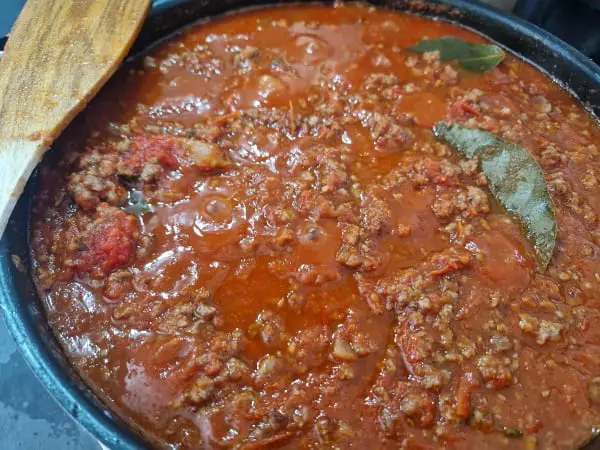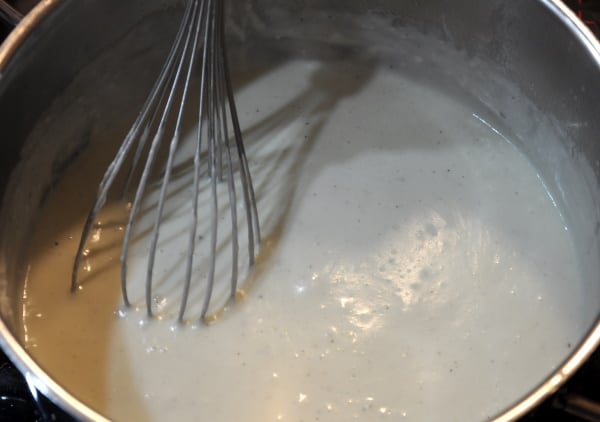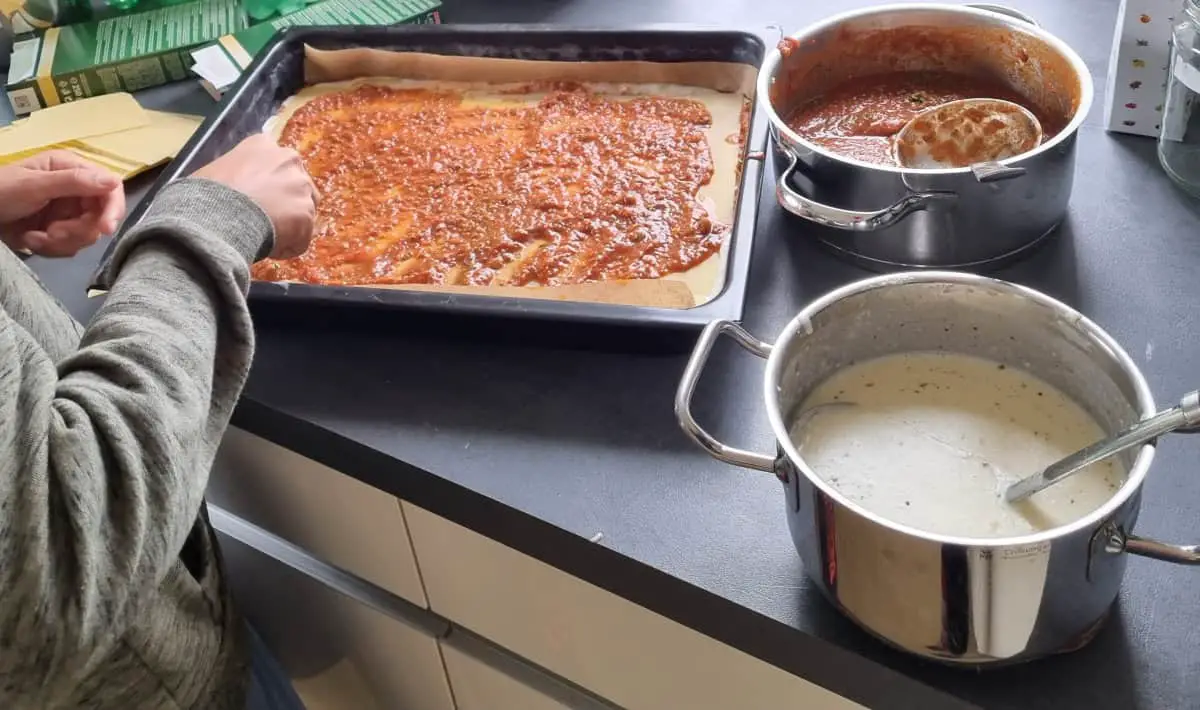Pulling the lasagna out of the oven, the edges are bubbling, the top layer of cheese is grilled to perfection, and you get excited to savor the taste of your masterpiece as the scent permeates the air.
You cut out a piece but notice the dish is very watery as the lasagna tumbles off the serving spoon.
What could have gone wrong, you wonder?
A lasagna may turn out soupy for several reasons, including, using too much (thin) sauce, using the wrong measurements when cooking, too many layers in the lasagne, overfilling the dish, slicing the pasta before it has cooled down, using vegetables that give off moisture, noodles that are wet, not draining ricotta before using it, or not draining the fat from the meat.
How do I make lasagna not watery?
Freezing lasagna will not reduce the water content. To make lasagna more firm, make sure that you follow the recipe accordingly when preparing the dish. This will result in lasagna that holds together when serving.
1. Measuring ingredients
Baking and cooking is an art. Always follow the recipe and make sure you portion out ingredients accurately. Eyeballing, leaving out certain ingredients, or substituting ingredients may all cause your lasagna dish to come out watery. This also applies to incorporating vegetables that have a high water content such as tomatoes that are 94% water.
2. Thaw frozen vegetables
Vegetables are made up of 90% water. When the vegetables are left to thaw during the cooking process, it releases the water stored in the cell walls of the vegetable. This will result in an overly watery lasagna. It is best to thaw out the vegetables first and drain the excess water.
3. Pre-cook your vegetables before using them
If possible, always use fresh vegetables as they contain less water than frozen vegetables. Reduce the moisture in the vegetables by either sauteing or par-cooking the vegetables. The heat will help to disintegrate most of the excess moisture.
4. Lean beef vs fatty beef
Contrary to what many believe, leaner meat actually contains higher amounts of water. For example, ground beef that is 85% lean meat will produce a 60% water content after being cooked, while ground beef that is 75% lean meat will produce 50% water content after being cooked.
Fatty beef actually only adds more flavor.
5. Reduce the liquid in your meat sauce
The meat sauce may contain too much liquid. Either drain the excess liquid in the meat sauce or reduce the sauce until most of the liquid has evaporated. You could also add tomato paste to help thicken it.
Most lasagna recipes call for a few fresh or canned tomatoes in the meat sauce. Certain vegetables, such as tomatoes, contain a very high water content which may affect the final result.

6. Thicken your béchamel sauce
Another big culprit may be a béchamel sauce that is too runny. You can thicken the sauce by adding a little bit of corn starch, flour, or even a pinch of baking soda. Alternatively, you could use less sauce in the dish.

7. Avoid overfilling
You may be tempted to add more meat sauce to the dish to enhance the flavor. This may in fact have the opposite effect and cause your lasagna to become watery. Always stick to the recipe and avoid over filling the dish.
8. Layering
Ideally, lasagna should have between three and four layers. Too many layers will prevent excess moisture from evaporating, resulting in watery lasagne.
9. Baking in a glass dish vs ceramic dish
A glass dish wins hands down because you are able to monitor the moisture in the dish as it cooks. Always opt to cook lasagna in a glass dish.
10. Use a thermometer
Ovens that are not properly calibrated will always result in over or undercooked dishes, regardless of how well you have followed the recipe.
Using an oven thermometer ensures that you will produce consistently good results every time.
11. Cool down period
The biggest mistake you could make is to slice into your lasagna just after you’ve taken it out of the oven. Allowing the lasagna to cool down slightly will help to set the lasagna and ensure that your lasagna is more firm when you cut into it.
It’s best to allow the dish to cool down for 30 minutes if possible.
How do you fix watery lasagna?
If the dish has already been cooked and it comes out watery, there is little you can do to save it. To thicken runny lasagna, sit the dish in the oven warmer and continuously check on it. This may help to “dry out” the dish, resulting in less liquid/moisture. But it takes time.
It is imperative though, that you keep an eye on the dish to prevent it from completely drying out.
Why is my frozen lasagna watery
Lasagna may be watery due to noodles that have absorbed too much liquid from the sauce. To prevent this, par-cook the noodles before layering the dish and allow them to finish cooking in the oven. Alternatively, place the noodles in a colander and allow them to dry completely before adding them to the dish.
Some recipes prefer to use ricotta or cottage cheese, which both contain high amounts of moisture. Use a sieve/cheesecloth to drain out excess moisture from your cheese before using it in the recipe.
How to make veggie lasagna not watery
Certain vegetables contain much higher amounts of water than others. You can prevent your pasta vegetable lasagna dish from being watery by salting the vegetables before sauteing them.
The salt helps to extract excess moisture and so does sauteing the veggies. Use a teaspoon of salt per pound of vegetables and allow the vegetables to sit for 30 to 45 minutes.
Keep in mind that not all veggies should be salted. Mushrooms, carrots, and bell peppers should preferably only be sauteed as this will be sufficient to remove moisture.
How to fix watery zucchini lasagna
The sad reality is that once the dish has been cooked it becomes very difficult to remove the excess liquid.
The best course of action would be to allow the dish to sit in the oven warmer for ten minutes or more. This will help to evaporate any excess liquid and make the dish more dry.
How to make zucchini lasagna not watery
Roast the zucchini before adding layers to the dish. This will remove large amounts of water. Alternatively, you could cut the zucchini into much thinner slices, salt the slices, and allow to rest for 15 minutes so that moisture can be drawn out.
The tomato sauce contains a lot of moisture, go easy on the sauce and thicken it with cornstarch. Also, allow the dish to set for 30 minutes before slicing into it.
How to make eggplant lasagna not watery
Before assembling your lasagna dish, cut up the eggplant and salt the exposed area with kosher salt. Lay the pieces on a paper towel and allow 15 minutes for the moisture to draw out of the eggplant. Pat the eggplant dry and saute it before adding layers to your lasagna dish.
If you want you can also pre-roast the slices in olive oil which will make them tastier and even less watery.

